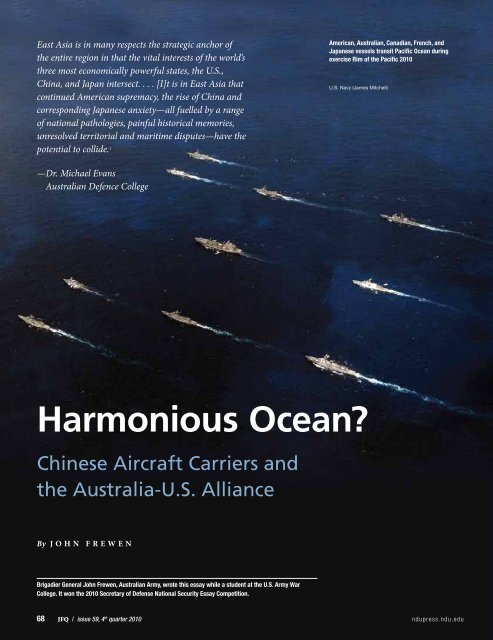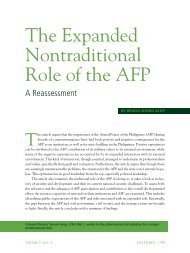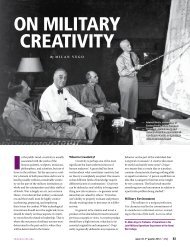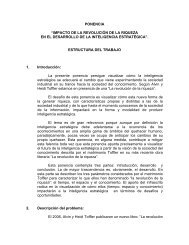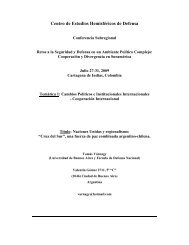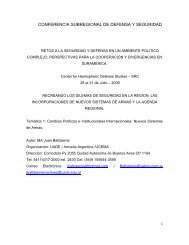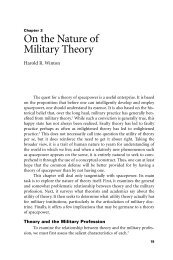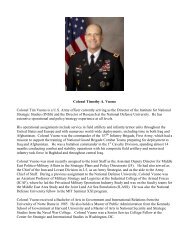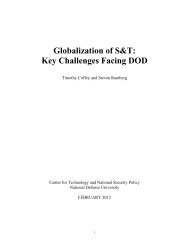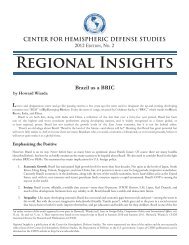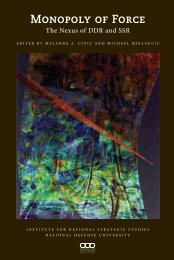Harmonious Ocean? - National Defense University
Harmonious Ocean? - National Defense University
Harmonious Ocean? - National Defense University
Create successful ePaper yourself
Turn your PDF publications into a flip-book with our unique Google optimized e-Paper software.
East Asia is in many respects the strategic anchor of<br />
the entire region in that the vital interests of the world’s<br />
three most economically powerful states, the U.S.,<br />
China, and Japan intersect. . . . [I]t is in East Asia that<br />
continued American supremacy, the rise of China and<br />
corresponding Japanese anxiety—all fuelled by a range<br />
of national pathologies, painful historical memories,<br />
unresolved territorial and maritime disputes—have the<br />
potential to collide. 1<br />
—Dr. Michael Evans<br />
Australian Defence College<br />
<strong>Harmonious</strong> <strong>Ocean</strong>?<br />
Chinese Aircraft Carriers and<br />
the Australia-U.S. Alliance<br />
By J o h n F r e w e n<br />
Brigadier General John Frewen, Australian Army, wrote this essay while a student at the U.S. Army War<br />
College. It won the 2010 Secretary of <strong>Defense</strong> <strong>National</strong> Security Essay Competition.<br />
American, Australian, Canadian, French, and<br />
Japanese vessels transit Pacific <strong>Ocean</strong> during<br />
exercise Rim of the Pacific 2010<br />
U.S. Navy (James Mitchell)<br />
68 JFQ / issue 59, 4 th quarter 2010 ndupress.ndu.edu
In March 2009, China’s <strong>Defense</strong> Minister,<br />
Liang Guanglie, announced that<br />
China planned to equip the People’s<br />
Liberation Army Navy (PLAN) with<br />
two conventional aircraft carriers by 2015. 2<br />
China has not previously pursued this capability<br />
formally. Unconfirmed media reports<br />
suggest that China will possibly also seek two<br />
additional nuclear-powered carriers by 2020.<br />
China justifies the procurement of carriers as<br />
logical for a nation of its size and economic<br />
influence, and necessary to defend its interests.<br />
3 For the Chinese people, carriers will be<br />
the jewels in the crown of a powerful navy, one<br />
befitting China’s rising great nation status.<br />
Having shaken off subjugation by<br />
foreign powers during the 18 th and 19 th centuries,<br />
China is moving rapidly toward the<br />
center of the international stage. After 30<br />
years of remarkable economic growth and a<br />
reshaping of the world’s economic landscape<br />
in its favor, China is poised to step into a new,<br />
possibly global, era. 4 Proud of its culture, traditions,<br />
and rising international status, China<br />
views the next 15 to 20 years as a “strategic<br />
window of opportunity”—a time for “national<br />
revitalization through continued economic,<br />
social and military development.” 5<br />
China’s emerging role in global affairs is,<br />
as yet, uncertain. The nation has unresolved<br />
historical and domestic issues that color its<br />
strategic judgments and make its intentions<br />
difficult to predict. It is also possible that<br />
China is growing and changing in ways the<br />
ruling Chinese Communist Party (CCP)<br />
cannot control or predict. Accompanying<br />
rapid economic growth are burgeoning<br />
maritime trade and energy requirements,<br />
a growing middle class, and an increase in<br />
nationalism. 6 In addition to these challenges,<br />
the CCP faces domestic poverty, rising unemployment,<br />
criticism of its own performance,<br />
a leadership transition in 2012, and a range of<br />
separatist movements.<br />
Of all of these, the CCP’s uneasy<br />
social contract with its increasingly affluent<br />
middle class is most notable. 7 If the CCP is<br />
to retain its one-party rule, it must continue<br />
to deliver increasing prosperity and individual<br />
convenience, in part by ensuring China’s<br />
access to trade and resources, particularly<br />
oil. Chinese strategists are acutely aware<br />
that they could do little in response if the<br />
United States chose tomorrow to constrict<br />
China’s maritime access to oil, minerals, and<br />
markets. 8 China’s concern for its strategic<br />
sea lanes, and a sense that great nations have<br />
great navies, has drawn it to a carrier force<br />
of its own. 9<br />
The appearance of the first Chinese<br />
aircraft carrier in the Pacific will resonate<br />
throughout the region and change the current<br />
dynamic. In Australia’s case, the carriers<br />
present a particular conundrum. Australia’s<br />
defense and security policy has been underpinned<br />
by its traditional friendship and alliance<br />
with the United States since World War<br />
II. However, since 2007, China has become<br />
Australia’s primary trading partner. 10 Any<br />
future tensions or conflict between the United<br />
States and China in the Pacific could place<br />
Australia in a potentially invidious position—<br />
torn between security and trade.<br />
This article discusses what Chinese carriers<br />
might mean to the Asia-Pacific region<br />
and the implications for Australia’s longstanding<br />
alliance with the United States, particularly<br />
in the event of escalating U.S.-China<br />
maritime tensions. Short of open conflict, the<br />
greatest risk presented by Chinese carriers is<br />
a self-fulfilling prophecy of a U.S.-China cold<br />
war. If conflict rather than accommodation<br />
is to mark China’s rise, Australia must weigh<br />
the relative benefits of its U.S. alliance against<br />
other alternatives—such as neutrality or<br />
defense self-sufficiency—before being caught<br />
in a conflict contrary to its long-term national<br />
interests.<br />
Background<br />
Uncontested U.S. primacy in the Asia-<br />
Pacific has been a source of great stability for<br />
over half a century. For instance, between July<br />
1995 and March 1996, the deployment of two<br />
U.S. carrier battlegroups to the South China<br />
Sea defused escalating tensions between<br />
China and Taiwan. At the time, the role of<br />
the carrier groups in the standoff infuriated<br />
the Chinese. This response, and U.S.<br />
Secretary of <strong>Defense</strong> William Perry’s boast<br />
that “while the Chinese are a great military<br />
power, the premier—the strongest—military<br />
power in the Western Pacific is the United<br />
States,” 11 contributed to a long-term Chinese<br />
determination to counter overwhelming U.S.<br />
maritime might.<br />
The People’s Republic of China began a<br />
military modernization program in the 1990s<br />
to develop the ability to fight “local wars<br />
under modern, high-tech conditions.” 12 This<br />
process accelerated following the intervention<br />
of U.S. carriers regarding Taiwan. A study of<br />
U.S. tactics in the first Gulf War, and the role<br />
of U.S. carriers in the Taiwan dispute, over-<br />
FREWEN<br />
turned the PLAN’s longstanding preference<br />
for submarine forces that, until then, had been<br />
more prominent in China’s naval development.<br />
13 China has since undertaken a range of<br />
activities to develop a carrier capability.<br />
In 1992, the CCP authorized a program<br />
to study the development of a carrier. The<br />
PLAN subsequently acquired four retired<br />
aircraft carriers for research purposes<br />
short of open conflict, the<br />
greatest risk presented by<br />
Chinese carriers is a<br />
self-fulfilling prophecy of a<br />
U.S.-China cold war<br />
(including the former Australian HMAS<br />
Melbourne). Another of these four, a former<br />
Soviet Kuznetsov-class carrier, the Varyag,<br />
has been refitted in China’s Dalian shipyards<br />
to “operational” status as a training carrier.<br />
It is likely that the PLAN’s next step will be<br />
to produce a medium-sized carrier (40,000–<br />
60,000 displaced tons) capable of handling<br />
conventional takeoff and landing or vertical/<br />
short takeoff and landing aircraft. 14<br />
Although China’s shipbuilding industry<br />
faces significant challenges in producing carriers,<br />
it could deliver a moderately effective<br />
indigenous aircraft carrier within a decade. 15<br />
However, it will take China longer than that<br />
to acquire a sophisticated and mature carrier<br />
capability comparable to U.S. equivalents. This<br />
will require advanced technologies, command<br />
and control systems, aviation abilities, and<br />
ship defenses that will take years to perfect—<br />
and training personnel will take time. 16 It<br />
is unlikely that China could surpass U.S.<br />
technological and naval dominance in any<br />
broad sense for decades. 17 Therefore, the region<br />
has the opportunity, albeit a fleeting one, to<br />
prepare for the impact of Chinese carriers.<br />
The Geopolitical Reality<br />
China shares borders with 14 countries<br />
and has ongoing maritime disputes with a<br />
number of them. China’s dispute with the<br />
United States over Taiwan is ongoing, as are<br />
standoffs with Japan, Malaysia, Vietnam, and<br />
the Philippines over the Spratly Islands archipelago<br />
(which straddles international shipping<br />
lanes through the South China Sea) and other<br />
contested territories. 18<br />
China also faces internal secessionist<br />
movements in Tibet and from the Uighurs (the<br />
ndupress.ndu.edu issue 59, 4 th quarter 2010 / JFQ 69
ESSAY WINNERS | <strong>Harmonious</strong> <strong>Ocean</strong>?<br />
East Turkestan Islamic Movement) in Xinjiang.<br />
Each of these attracts international criticism<br />
of Beijing’s human rights record. China<br />
is highly sensitive to foreign criticism and<br />
interference, and is disgruntled with neighbors<br />
who have sought to resolve territorial disputes<br />
through international bodies such as the Association<br />
of Southeast Asian Nations (ASEAN)<br />
or the United Nations (UN).<br />
China’s massive economy and domestic<br />
affluence depend on foreign trade and a sure<br />
supply of energy. Accordingly, energy security<br />
and trade are China’s paramount maritime<br />
concerns. Maintaining a huge merchant<br />
marine fleet, and ensuring its freedom of<br />
access and security, will be an ongoing challenge.<br />
Satisfying exponentially rising energy<br />
demands in parallel with other burgeoning<br />
economies such as India and Brazil will<br />
be another.<br />
Chinese President Hu Jintao has<br />
bemoaned China’s “Malacca dilemma,” which<br />
consists of up to 40 percent of its imported<br />
oil passing through these straits without a<br />
concomitant ability to ensure free passage. 19<br />
In response, the government has adopted<br />
a “string of pearls” strategy for the Indian<br />
<strong>Ocean</strong> to reduce reliance on the Malacca<br />
Straits. This consists of ports, bases, and facilities<br />
in friendly countries designed to transport<br />
oil and other energy resources via roads and<br />
pipelines from the Indian <strong>Ocean</strong> into China. 20<br />
Carriers will be a reassuring capability for the<br />
Chinese in this context but one of concern for<br />
other nations.<br />
The sheer size of China’s population,<br />
markets, and economy makes it a source<br />
of immense potential prosperity for many<br />
regional nations. These nations have a large<br />
stake in China’s peaceful rise, just as China<br />
has a vested interest in maintaining the conditions<br />
that have supported its rise—including<br />
the stable international order created by U.S.<br />
security efforts over recent decades. Economic<br />
interdependence can be a positive and stabilizing<br />
influence if China continues to need the<br />
world as much as the world needs it. However,<br />
Beijing’s suspicions of U.S. motivations and<br />
resistance to formal security arrangements<br />
create an unnerving perception of Chinese<br />
monolithic unilateralism.<br />
The Asia-Pacific has no binding identity<br />
comparable to the North Atlantic Treaty<br />
Organization. Each Asia-Pacific nation has<br />
unique circumstances and interests, and it is<br />
not possible to define a regional perspective. 21<br />
Five U.S. defense allies (Australia, Japan,<br />
South Korea, Thailand, and the Philippines)<br />
and close partner Singapore remain committed<br />
to Washington as the guarantor of<br />
regional security. What has changed is that<br />
China has supplanted the United States economically<br />
as the major trading partner of each<br />
of these nations.<br />
These countries now face what Michael<br />
Evans describes as an “economic-strategic dissonance”<br />
whereby their economic prosperity<br />
is linked to continuing Chinese growth but is<br />
underwritten by the United States balancing<br />
China’s rise. 22 None of these nations wants<br />
Beijing to become too strong or too weak.<br />
An assertive China is a cause for concern, yet<br />
so is a floundering China that inadvertently<br />
exports its instability. In essence, China’s rise<br />
is making the United States more relevant, not<br />
less, and there is little risk of U.S. influence<br />
waning in the region. But Chinese carriers<br />
could change perceptions of American<br />
regional preeminence.<br />
Notwithstanding the financial and<br />
technological challenges ahead, acquisition<br />
of a substantive carrier capability appears<br />
inevitable. China aims to avoid the mistakes<br />
of earlier rising powers such as Nazi Germany<br />
and Imperial Japan, which staked claims to<br />
global leadership and directly challenged the<br />
dominant powers of the time. Instead, China<br />
is seeking to shape the global rules, norms,<br />
and institutions that may affect its economic<br />
future. Accordingly, one of its foreign policy<br />
objectives is to reassure other countries that<br />
its rise does not threaten their economic or<br />
security interests. 23 This will be difficult to<br />
achieve within the current CCP context of<br />
introversion, sensitivity, and intrigue. 24<br />
What Do Chinese Carriers Signify?<br />
Despite President Hu’s assurance that<br />
for “now and in the future, China would<br />
never seek hegemony, nor would it turn to<br />
military expansion or arms races with other<br />
nations,” 25 the carriers will be an unsettling<br />
symbol of China’s growing military might for<br />
nations in the Asia-Pacific. Carriers represent<br />
military power projection in the purest sense,<br />
and seem incongruous with China’s professed<br />
policy of noninterference in the affairs of<br />
other states.<br />
The carriers will compound existing<br />
regional concerns about China’s lack of transparency<br />
in governmental processes, including<br />
uncertainty about the role of its military in<br />
policymaking and the increasing use of “soft<br />
power” diplomacy to expand global influence.<br />
Australia’s 2009 Defence White Paper called<br />
on China to “do more” to explain why its military<br />
modernization appears beyond the scope<br />
required for a conflict over Taiwan. 26 At best,<br />
uncertainty “dominates the circumstances of<br />
China’s economic rise.” 27<br />
Chinese leaders argue that their country<br />
“is totally transparent in strategic intentions”<br />
28 and that the United States maintains<br />
a Cold War mentality with respect to China.<br />
The United States insists on the right of<br />
military aircraft to operate 12 nautical miles<br />
from China’s coastline in defiance of China’s<br />
stated 200-nautical-mile exclusion zone (the<br />
same distance the United States and Russia<br />
maintained off each other’s coasts during the<br />
Cold War). This has created overt animosity<br />
between the U.S. Navy and PLAN for over<br />
a decade. Future incidents are likely to be<br />
exacerbated by the intervention of a Chinese<br />
carrier group.<br />
In a practical sense, 2 or even 4 Chinese<br />
carriers would not alter the overwhelming<br />
military advantage maintained by the U.S.<br />
China’s rise is making the United States more relevant, not less,<br />
and there is little risk of U.S. influence waning in the region<br />
Navy’s 11 sophisticated carrier battlegroups.<br />
The U.S. experience is that it takes three<br />
carriers to maintain one ready for sea. In<br />
this light, it will be many years before the<br />
PLAN could hope to generate a consistent<br />
carrier presence. Others argue that the U.S.<br />
Armed Forces will maintain their qualitative<br />
military and technological edge, particularly<br />
in space, and Chinese carriers will merely<br />
become additional targets for U.S. aircraft<br />
and cruise missiles.<br />
China is, therefore, also pursuing<br />
complementary technological and asymmetric<br />
capabilities that could counter or neutralize<br />
overwhelming U.S. military advantages.<br />
These capabilities, often generically referred<br />
to as the “Assassin’s Mace” 29 reportedly<br />
include antiship cruise missiles, antisatellite<br />
missiles, and stealth, nano-, and cyberwarfare<br />
technologies. The successful Chinese<br />
test of an antisatellite missile in January 2007<br />
70 JFQ / issue 59, 4 th quarter 2010 ndupress.ndu.edu
U.S. Navy (Mark R. Alvarez)<br />
and the potential for mysterious Chinese<br />
capabilities fuel concerns about Beijing’s strategic<br />
intentions.<br />
Some believe these technologies are<br />
beyond China’s immediate reach or that they<br />
can be defeated by emerging U.S. capabilities.<br />
Others portend a “technological Pearl<br />
Harbor” (consistent with a Chinese strategic<br />
USS Essex and USS Denver operate<br />
with Philippine navy ship BRP<br />
Dagupan City in South China Sea<br />
during exercise Balikatan 2010<br />
culture that values surprise and deception) in<br />
which U.S. command systems are paralyzed<br />
or a major platform is destroyed by potent<br />
secret weapons. 30 On balance, it is reasonable<br />
to assume that China is seeking capability<br />
advantages, as do all military powers, but as<br />
yet it has not exhibited any aggressive intent.<br />
What Will Chinese Carriers Do?<br />
In 2004, President Hu expanded the<br />
PLAN role to include “safeguarding China’s<br />
expanding national interests and ensuring<br />
world peace.” 31 This extended the PLAN focus<br />
beyond Taiwan and maritime sovereignty<br />
toward protection of China’s increasingly<br />
important international sea lines of communication.<br />
China’s role in recent years in international<br />
institutions, including supporting<br />
UN Security Council resolutions (a shift from<br />
the previously strict belief in noninterference<br />
in the internal affairs of states) and participation<br />
in coalition counterpiracy operations off<br />
the coast of Somalia, supports this intent.<br />
Major General Qian Lihua, director<br />
of the <strong>Defense</strong> Ministry’s foreign affairs<br />
office, stated, “The question is not whether<br />
you have an aircraft carrier, but what you<br />
do with your aircraft carrier.” 32 He added,<br />
“Unlike another country,<br />
we will not use [a carrier] to<br />
pursue global deployment<br />
or global reach.” Instead,<br />
he described a carrier’s<br />
purpose as offshore defense. 33<br />
However, there is little utility<br />
for carriers in sea denial of<br />
China’s coastal areas or in a<br />
direct role in an operation<br />
to seize Taiwan, as airpower<br />
can be projected from the<br />
mainland.<br />
The real utility of carriers<br />
is providing air cover for<br />
forces conducting sea control<br />
and sea denial away from<br />
China’s shores and outside<br />
the range of its land-based<br />
air defense. In this context,<br />
“PLAN officers speak of<br />
developing three oceangoing<br />
fleets, one to patrol the areas<br />
around Korea and Japan,<br />
another to push out to the<br />
Western Pacific and a third<br />
to protect the Indian <strong>Ocean</strong><br />
and the Straits of Malacca.” 34<br />
Chinese carriers could detect<br />
and interdict forces in the Pacific <strong>Ocean</strong>,<br />
ensure sea passage through the Malacca<br />
Straits, or protect string-of-pearls bases<br />
across the length of China’s strategic sea<br />
supply routes into the Indian <strong>Ocean</strong>.<br />
The high risk of losing a carrier to<br />
U.S. weapons or provoking an escalating<br />
American or regional response (including<br />
a nuclear one) makes an aggressive carrier<br />
posture unlikely. However, it is possible that a<br />
Chinese carrier group could deter or delay an<br />
intervention by U.S. carrier groups, or apply<br />
pressure during a standoff or negotiation,<br />
while avoiding direct confrontation. It is also<br />
conceivable, in a conventional sense, that<br />
China could achieve some form of limited<br />
local sea dominance against U.S. or coalition<br />
naval forces, or win a localized, short,<br />
high-intensity naval engagement for strategic<br />
advantage. In these circumstances, Chinese<br />
FREWEN<br />
carriers would challenge the perception of<br />
U.S. maritime dominance in the Pacific.<br />
Carriers also offer the CCP the means<br />
to posture in ways not available to them at<br />
present. Carriers could be used with economic<br />
and cultural tools to persuade and coerce,<br />
such as protecting blockading ships from air,<br />
surface, and subsurface threats. Furthermore,<br />
a carrier might play “smart power” roles, such<br />
as evacuation operations in support of China’s<br />
immense international diasporas or humanitarian<br />
interventions.<br />
In one sense, a carrier group may present<br />
China with a “Great Red Fleet” to extend<br />
influence and authority in a manner reminiscent<br />
of President Theodore Roosevelt’s Great<br />
White Fleet of 1907–1909. At a minimum, the<br />
carriers herald an increasing presence in the<br />
it will be many years before<br />
the PLAN could hope to<br />
generate a consistent<br />
carrier presence<br />
Pacific that will require accommodation by the<br />
United States and other regional nations. Short<br />
of the unlikely event of open conflict, Chinese<br />
carriers will be as much about perceptions as<br />
tactical effect, and will complicate the strategic<br />
calculations of others.<br />
The Risks of Chinese Carriers<br />
In 2008, a Chinese admiral offered the<br />
commander of U.S. Pacific Command a division<br />
of the Pacific <strong>Ocean</strong> between their two<br />
countries once China had carriers. 35 In 2009,<br />
China hardened its position on the Spratly<br />
Islands, pushing for bilateral rather than<br />
international resolution of the territorial disputes.<br />
Both stances indicate China’s growing<br />
diplomatic confidence and a determination to<br />
avoid checking of its strategic intentions.<br />
The United States is wary of Chinese<br />
military intentions in the Asia-Pacific<br />
and conscious of regional nations’ unease.<br />
Militarily speaking, China’s procurement of<br />
antiaccess and area-denial weapons is of the<br />
most concern. Strategically, there is a risk<br />
for the United States that regional nations<br />
might shift from U.S.-China fence-sitting to<br />
“bandwagoning” with China. As Australian<br />
strategist Hugh White asserts, “As the British<br />
discovered and as the Chinese discovered,<br />
once you lose economic primacy, strategic<br />
primacy follows pretty quickly.” 36<br />
ndupress.ndu.edu issue 59, 4 th quarter 2010 / JFQ 71
U.S. Air Force (Bradley Lail)<br />
ESSAY WINNERS | <strong>Harmonious</strong> <strong>Ocean</strong>?<br />
Washington’s policy will remain a key<br />
variable for the region, and its responses to<br />
Chinese carriers will be closely watched. The<br />
region will act with confidence if the United<br />
States remains economically significant<br />
and a security guarantor. It could become<br />
unsettled if the United States is perceived as<br />
inadequately committed or if it engages China<br />
insensitively. At worst, an ambiguous U.S.<br />
response could trigger a militarily resurgent<br />
Japan or accelerate the current widespread<br />
regional naval modernization into a maritime<br />
arms race.<br />
In 2007, the U.S. Pacific Fleet for the<br />
first time had more ships assigned to it than<br />
the Atlantic Fleet. 37 While this is a prudent<br />
military contingency response, and reassuring<br />
to allies, it could conversely be perceived<br />
by China as an aggressive U.S. containment<br />
policy, thereby hardening Beijing’s competitive<br />
resolve and potentially provoking an<br />
antagonistic strategic response—increasing<br />
the likelihood of tensions between the PLAN<br />
and the U.S. Navy. The correct balance will<br />
remain difficult to find.<br />
While outright Chinese aggression<br />
appears unlikely in the next decade or so,<br />
Chinese carriers operating in the South<br />
China Sea and the Pacific will encounter<br />
ships from Australia, Indonesia, Japan,<br />
Malaysia, Singapore, South Korea, the<br />
Philippines, Vietnam, and the United States. 38<br />
These nations have competing interests<br />
and maintain surveillance on each others’<br />
activities. The new carriers would increase<br />
suspicion and amplify tensions.<br />
A series of attempts to build confidence<br />
and develop Chinese and American bilateral<br />
agreements have met with little success. None<br />
has delivered enduring or effective means of<br />
managing crises between the two countries. 39<br />
Some are concerned that no “Incident at Sea”–<br />
type of agreement exists between the United<br />
States and China, as existed to defuse tensions<br />
between the United States and the Soviet<br />
Union from 1972. Whether future naval tensions<br />
arise from longstanding disputes, from<br />
Sailor stands watch in USS Essex combat<br />
information center during detect-to-engage<br />
drill in South China Sea<br />
CCP exploitation of nationalistic sentiments,<br />
or from some apparently trivial event, a<br />
Chinese carrier group could raise the stakes<br />
(and emotions) and increase the possibility of<br />
an incident escalating unintentionally.<br />
The unintended consequences of<br />
Chinese carriers pose the greatest threat<br />
to regional harmony in the decades ahead.<br />
Without an agreement to moderate sea<br />
incidents, it may be impossible to realize<br />
a “harmonious ocean” between a Chinese<br />
carrier-capable navy and other regional navies<br />
in the South China Sea and Pacific. 40<br />
The Australian Context<br />
Australia shifted its security reliance<br />
from Great Britain to the United States after<br />
the sinking of HMS Repulse and HMS Prince<br />
of Wales on December 10, 1941, just days<br />
after Pearl Harbor. A lack of air cover and<br />
arguably the absence of a carrier permitted<br />
this catastrophe. The loss of these two British<br />
ships effectively destroyed Singapore’s naval<br />
protection, just when Australia feared a<br />
Japanese attack if Singapore fell. This shook<br />
Australia and exposed Britain’s inadequate<br />
commitment to defending its former colony.<br />
Ever since, Australia has looked to the United<br />
States as its principal security ally.<br />
Cultural ties with and a debt of gratitude<br />
to the United States run deep in Australia.<br />
The Australia, New Zealand, and U.S. Security<br />
Treaty of 1951 is a military alliance on<br />
defense matters in the Pacific region. It binds<br />
Australia and the United States to common<br />
defense in the event of an attack on either<br />
country. The treaty has dominated Australian<br />
strategic thought since World War II and has,<br />
in effect, allowed Australia to forsake a strategy<br />
of defense self-sufficiency. Canberra has<br />
faithfully supported U.S. security endeavors<br />
from Vietnam to Iraq and Afghanistan, and<br />
benefited by maintaining a relatively small,<br />
albeit professional, defense force.<br />
Once a British colonial outpost, Australia<br />
has gradually drawn closer to Asia in<br />
population composition and economic focus.<br />
At present, Japan and China are Australia’s<br />
major export markets, and it actively seeks<br />
a closer relationship with regional organizations<br />
such as ASEAN. Former Prime Minister<br />
Kevin Rudd was the first Western leader<br />
fluent in Mandarin. Regardless, recent Australian-Sino<br />
relations have been mixed, largely<br />
due to Chinese resentment over Australian<br />
rules for foreign investment and the tone of<br />
Australia’s 2009 Defence White Paper, which<br />
sets out strategy and military spending priorities<br />
until 2030.<br />
The White Paper identifies China’s rise<br />
as a challenge but falls short of describing it<br />
as a direct threat. However, the inference is<br />
not difficult to draw, as the paper cautions<br />
China that the “pace, scope and structure”<br />
of its military buildup appears “beyond that<br />
required for a conflict over Taiwan” and cause<br />
for regional concern in the absence of further<br />
explanation. 41 The paper also announces a<br />
surprising addition of 12 submarines, effectively<br />
doubling the presently undermanned<br />
Australian fleet. 42 No precise role is offered<br />
for these submarines other than “sea control<br />
including freedom of navigation and the protection<br />
of shipping.” 43<br />
These submarines appear intended to<br />
deny the maritime approaches to Australia,<br />
to protect Australian trade routes and shipping,<br />
and, if required, to contribute usefully<br />
72 JFQ / issue 59, 4 th quarter 2010 ndupress.ndu.edu
to a U.S.-led coalition against a maritime<br />
force. The tenor of the White Paper and the<br />
submarine fleet expansion angered China<br />
while underscoring the enduring centrality<br />
of the Australia-U.S. alliance. Former Prime<br />
Minister Rudd had further reinforced Australia’s<br />
ongoing security reliance on the United<br />
States by describing China as a partner and<br />
the United States as a strategic ally.<br />
Australia’s conundrum is now two-fold:<br />
how to avoid U.S. policy drawing China (and<br />
by default Australia) into conflict, and how<br />
to accommodate Chinese interests without<br />
undermining the U.S. alliance. An additional<br />
challenge is moderating Australian coordination<br />
with the United States to avoid losing an<br />
independent voice with China.<br />
In the event of escalating U.S.-China<br />
tensions, Australia could assume different<br />
roles. One is trusted middleman, working<br />
to achieve accommodation over conflict<br />
between the two great powers. Australia’s<br />
close historical and cultural relationship<br />
with the United States and its growing<br />
independent trade and regional ties with<br />
China have it uniquely placed to mediate if<br />
U.S.-China relations should sour to the point<br />
of an incommunicative posture. Evidence of<br />
the developing strength of Australia’s relationship<br />
was recently seen in Chinese Vice<br />
Premier Li Keqiang lavishing “extraordinary<br />
praise” on Australia as a partner and friend<br />
during a visit in October 2009, despite the<br />
recent frictions. 44<br />
Alternatively, Australia could become<br />
marginalized as tensions rise, losing the ear<br />
of both nations, particularly if it is perceived<br />
as militarily irrelevant or a military minion<br />
of the United States. Australia requires a sufficiently<br />
independent defense policy and an<br />
effective level of military deterrence to retain<br />
Chinese respect. At present, Australia does<br />
not maintain adequate deterrent capability<br />
against a nation of China’s might without<br />
U.S. backing and will remain dependent<br />
on support from U.S. capabilities until at<br />
least 2030 under the financial constraints of<br />
the current White Paper. True defense selfsufficiency<br />
poses significant challenges to<br />
Australian policymakers.<br />
At worst, Australia could be martyred in<br />
a U.S.-China conflict if it honors its alliance<br />
with the United States but finds its military<br />
capacity seriously degraded and its trade with<br />
China suspended. Australia lacks strategic<br />
depth in its major platforms and relies on a<br />
technological advantage over other regional<br />
powers to deter or defend against attack.<br />
Being drawn into a conventional force-onforce<br />
conflict at sea could be devastating to<br />
the Royal Australian Navy. A major Chinese<br />
strike (possibly even nuclear) against U.S.<br />
installations on Australian soil would be a<br />
momentous political test for any Australian<br />
government, and it would be beyond Australia’s<br />
capacity to retaliate decisively. Such a predicament<br />
would be compounded if U.S. maritime<br />
dominance fell into question as Australia<br />
was trying to regenerate major capabilities.<br />
In this regard, the recent Defence White<br />
Paper has been criticized as ambiguous by<br />
several foreign policy commentators. 45 Hugh<br />
White has accused it of deferring the “hard<br />
decisions” of how to respond to China’s rise,<br />
former Prime Minister Rudd had further reinforced Australia’s<br />
ongoing security reliance on the United States by describing<br />
China as a partner and the United States as a strategic ally<br />
and of failing to account for how an eclipse<br />
of U.S. primacy might reshape Australia’s<br />
strategic objectives and operational capabilities.<br />
His concern is that self-reliance is not<br />
realistically considered, nor are preparations<br />
adequate for escalating tensions between the<br />
United States and China. Of course, budgetary<br />
considerations have guided Australia’s<br />
present strategy.<br />
White asked, “Do we stay with the U.S.<br />
as it becomes drawn deeper into a competitive<br />
relationship with China? I think the answer is<br />
quite probably not.” 46 His answer is heretical<br />
to many, suggesting the almost unthinkable:<br />
that Australia might remain neutral—or<br />
perhaps even side with China—if a conflict<br />
with the United States were to emerge. While<br />
this possibility seems remote in the current<br />
political context, other regional nations may<br />
choose to take that path (particularly if it is<br />
paved with Chinese largesse). In these circumstances,<br />
either neutrality or an alternative<br />
alliance offers other options for Australia.<br />
An alliance with another regional<br />
nation such as Japan or possibly India might<br />
support a neutral stance but could still result<br />
FREWEN<br />
in Australia being drawn into a broadening<br />
U.S.-China conflict. A new alliance would<br />
also struggle to replicate the trust and surety<br />
associated with the well-tested U.S. alliance,<br />
at least for many decades. Australian full neutrality<br />
could not be considered without actual<br />
defense self-reliance.<br />
Australia’s 2009 Defence White Paper<br />
notes that U.S. nuclear protection has removed<br />
the need for Australia to consider more<br />
“significant and expensive defense options.” 47<br />
Although not named, these options could<br />
include aircraft carriers and nuclear weapons.<br />
Australia relinquished its carrier capability<br />
(HMAS Melbourne) in 1982 and has never<br />
pursued nuclear weapons. There is currently<br />
no Australian intention or public debate to<br />
acquire either. These capability options could<br />
require prominent consideration if China<br />
becomes militarily aggressive or the United<br />
States signals a withdrawal from the Pacific.<br />
Australia is well positioned to act as<br />
middleman during rising tensions between<br />
China and the United States despite the risk of<br />
marginalization. It should reinforce its status<br />
as a trusted interlocutor and valued independent<br />
agent (as evidenced by its regional leadership<br />
roles in East Timor and Solomon Islands)<br />
and continue to play a leading regional role in<br />
encouraging Chinese transparency. Australia<br />
can also champion an Incident at Sea–style<br />
agreement between China and other regional<br />
nations while continuing to develop military<br />
capabilities useful to both U.S.-led coalitions<br />
and regional security more broadly.<br />
In the event of an open conflict between<br />
China and the United States, Australia lacks<br />
the ability to provide air cover to a maritime<br />
force deployed away from its shores and has<br />
no independently credible deterrent to a major<br />
power, in isolation from the U.S. alliance. To<br />
mitigate these risks, Australia requires a more<br />
thorough consideration of the underpinnings<br />
of defense self-sufficiency, including a carrier<br />
capability and nuclear deterrence.<br />
Announcements about China’s carrier<br />
intentions are the latest manifestation of a<br />
growing military and maritime capability<br />
that is difficult to interpret but impossible to<br />
ignore. As ever, China remains enigmatic.<br />
What is certain is that the CCP faces a<br />
complex set of challenges to maintain China’s<br />
rise, meet its growing trade and energy<br />
requirements, and retain political power.<br />
China’s expanding interests, and its aircraft<br />
carriers, will unavoidably affect Australia’s<br />
ndupress.ndu.edu issue 59, 4 th quarter 2010 / JFQ 73
ESSAY WINNERS | <strong>Harmonious</strong> <strong>Ocean</strong>?<br />
strategic circumstances in the coming decades.<br />
Notwithstanding the military capabilities that<br />
carriers will afford China, miscalculations<br />
or misunderstandings from incidents at sea<br />
are the most significant threat to the peaceful<br />
inclusion of a carrier-capable Chinese navy in<br />
the Pacific.<br />
Each of the Pacific nations will manage<br />
China’s carrier ambitions differently, but the<br />
U.S. response will set the regional tone. For<br />
Australia, the choices include retaining U.S.<br />
security dependence, thereby risking a form<br />
of martyrdom, or pursuing greater defense<br />
self-sufficiency. The debate about genuine selfsufficiency<br />
has not been held in any substantial<br />
sense. Therefore, by default, the U.S. alliance<br />
will retain its primacy in Canberra’s strategic<br />
thought, and Australian military capabilities<br />
will evolve in accordance with the intent of the<br />
2009 Defence White Paper—at least until the<br />
time that Chinese carriers are likely to appear.<br />
Despite any good intentions, it appears<br />
unlikely that Chinese aircraft carriers could<br />
enhance harmony in the Pacific <strong>Ocean</strong>.<br />
There are still at least 5 years before China’s<br />
carriers appear on the horizon of its Pacific<br />
neighbors. Australia must consider not only<br />
the military implication of these carriers but<br />
also the perceptions they will create in terms<br />
of relative U.S.-China preeminence. It is best<br />
that this thinking is done before the carriers<br />
materialize in the Pacific. Developing an<br />
understanding of the regional perceptions<br />
of Chinese carriers will be important to<br />
achieving accommodation rather than conflict<br />
and to maintaining stability and confidence in<br />
the Asia-Pacific. JFQ<br />
N o T e S<br />
1 Michael Evans, “The Manchurian Paradox:<br />
Asia, the United States and the Global Balance of<br />
Power in the 21 st Century,” Quadrant 53, no. 9 (September<br />
2009), 3.<br />
2 “Aircraft Carrier Project,” available at<br />
; Wang Jianfen and Nie Ligao, “Japan<br />
<strong>Defense</strong> Minister’s China Visit a Sign of Warming<br />
Relations,” available at .<br />
3 China is currently the only United Nations<br />
Security Council permanent member without an<br />
aircraft carrier. See Michael Hall, The Blue Water<br />
Dragon: China’s Emerging Aircraft Carrier Force<br />
and U.S. Responses (Newport, RI: Naval War<br />
College, 2008), 5.<br />
4 See Andrew G. Walder, “Unruly Stability:<br />
Why China’s Regime Has Staying Power,” Current<br />
History 108, no. 719 (September 2009), 257. See<br />
also Evan S. Medeiros, “Is Beijing Ready for Global<br />
Leadership?” Current History 108, no. 719 (September<br />
2009), 250.<br />
5 Medeiros, 251.<br />
6 See “Angry China,” The Economist, May 1,<br />
2008.<br />
7 See Robert S. Ross, “China’s Naval <strong>National</strong>ism:<br />
Sources, Prospects, and the U.S. Response,”<br />
International Security 34, no. 2 (Fall 2009), 64.<br />
8 The United States is the only power that<br />
can control the entire world’s oceans and impede<br />
China’s flow of trade and energy resources.<br />
Aaron L. Friedberg and Robert S. Ross, “Here Be<br />
Dragons,” <strong>National</strong> Interest Online, September–<br />
October 2009, available at .<br />
9 See Andrew S. Erickson and Andrew R.<br />
Wilson, “China’s Aircraft Carrier Dilemma,” Naval<br />
War College Review 59, no. 4 (Autumn 2006), 28;<br />
and Edward Wong, “China Signals More Interest<br />
in Building Aircraft Carrier,” The New York Times,<br />
December 24, 2008.<br />
10 “China Emerges as Our Biggest Trade<br />
Partner,” The Australian, May 5, 2007; and Simon<br />
Crean, “Trade Figures Confirm China and Japan<br />
as Top Trade Partners,” May 6, 2008, available at<br />
.<br />
11 “Taiwan Strait, 21 July 1995 to 23 March<br />
1996,” available at .<br />
12 Richard Weitz, “Enduring Difficulties in<br />
China-U.S. <strong>Defense</strong> Diplomacy,” Korean Journal of<br />
<strong>Defense</strong> Analysis 21, no. 4 (December 2009), 394.<br />
13 See Erickson and Wilson, 29; Ross, 75.<br />
14 Hall, 7.<br />
15 See “Navy, China,” Jane’s Sentinel Country<br />
Risk Assessment, February 3, 2009; and Michael C.<br />
Grubb and Gabriel Collins, “Chinese Shipbuilding:<br />
Growing Fast but How Good Is It?” U.S. Naval Institute<br />
Proceedings 134, no. 3 (March 2008), 46–47.<br />
16 See Ronald O’Rourke, The Impact of Chinese<br />
Naval Modernization on the Future of the United<br />
States Navy (New York: Novinka Books, 2006), 17–18.<br />
17 Friedberg and Ross.<br />
18 See David Lai, “China’s Maritime Quest,”<br />
U.S. Army War College Strategic Studies Institute<br />
op-ed (June 2009), 2.<br />
19 st<br />
Robert Kaplan, “Center Stage for the 21<br />
Century: Rivalry in the Indian <strong>Ocean</strong>,” Foreign<br />
Affairs Online, March–April 2009, available<br />
at .<br />
20 Ibid.<br />
21 Dean Cheng, “Asia: Facing Interesting Times,”<br />
Joint Force Quarterly 55 (4th Quarter, 2009), 34.<br />
22 Evans, 6.<br />
23 Medeiros, 251–252.<br />
24 See Peng Kuang and Li Xiaokun, “Army<br />
Leader to Tour U.S. Military Sites,” China Daily,<br />
October 24, 2009.<br />
25 Announced at the PLAN “<strong>Harmonious</strong><br />
<strong>Ocean</strong>” 60th anniversary celebrations, April 23,<br />
2009. See Richard Weitz, “Global Insights: The<br />
Chinese Navy Throws a Party,” available at .<br />
26 Defending Australia in the Asia Pacific<br />
Century: Force 2030, Commonwealth of Australia,<br />
Defence White Paper 2009, 34.<br />
27 Evans, 1.<br />
28 Major General Qian Lihua, director of the<br />
Defence Ministry’s Foreign Affairs Office, quoted<br />
in “Army Leader to Tour U.S. Military Sites,” China<br />
Daily, October 24, 2009.<br />
29 Commentaries on Assassin’s Mace range<br />
from dismissive to fearful. Moderates portray<br />
the term as overused and comparable to that of<br />
silver bullet in English. See Alastair Iain Johnston,<br />
“Toward Contextualizing the Concept of a<br />
Shashoujian (Assassin’s Mace),” August 2002, available<br />
at .<br />
30 See David Lei, “China’s New Multi-Faceted<br />
Maritime Strategy,” Orbis 52, no. 1 (Winter 2008), 3.<br />
31 Office of Naval Intelligence (ONI), The People’s<br />
Liberation Navy: A Modern Navy with Chinese<br />
Characteristics (Washington, DC: ONI, July 2009), 9.<br />
32 Erickson and Wilson, 28.<br />
33 “China Hints at Aircraft Carrier Project,”<br />
The Financial Times, November 16, 2008.<br />
34 Lei, 3.<br />
35 In 2008, Admiral Timothy Keating, commander<br />
of U.S. Pacific Command, reported a<br />
conversation, seemingly in jest, in which a senior<br />
Chinese naval officer suggested drawing a line<br />
down the middle of the Pacific: “You guys can have<br />
the east part of the Pacific, Hawaii to the states.<br />
We’ll take the west part of the Pacific, from Hawaii<br />
to China.” Discussed in Friedberg and Ross.<br />
36 Patrick O’Connor, “Australia: Former Labor<br />
PM Keating denounces Rudd government’s ‘isolationist’<br />
stance on China,” July 10, 2009, available<br />
at .<br />
37 Peter Brookes, “Flashpoint: The Great<br />
Wall Goes to Sea,” Armed Forces Journal<br />
Online, available at .<br />
38 Weitz, 394.<br />
39 Ibid., 382–387.<br />
40 See Andrew Scobell, “Is There a Civil-<br />
Military Gap in China’s Peaceful Rise?” Parameters<br />
39, no. 2 (Summer 2009), 19.<br />
41 Defending Australia, 34.<br />
42 Ibid., 70.<br />
43 Ibid., 60.<br />
44 See Rowan Callick, “China Push to Heal Rift<br />
in Ties,” The Australian, October 31, 2009.<br />
45 O’Connor.<br />
74 JFQ / issue 59, 4 th quarter 2010 ndupress.ndu.edu<br />
46 Ibid.<br />
47 Defending Australia, 50.


